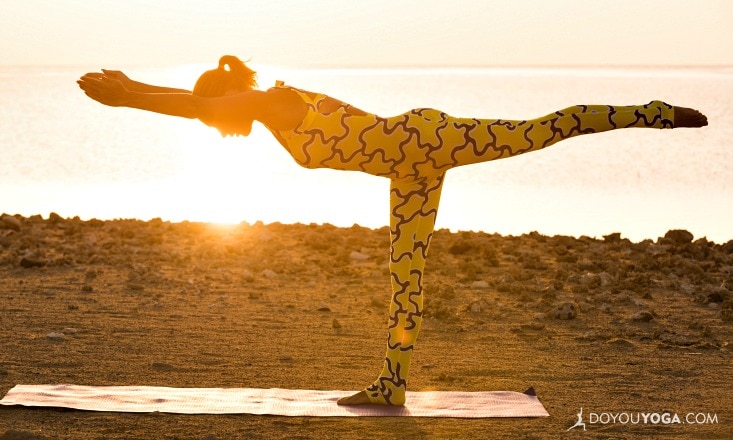Warrior I, II, and III are some of the most common postures in the yoga practice, and for good reason. They’re approachable for most bodies and are less intimidating than some of the more ‘advanced’ postures while still being great postures for building strength, confidence, and body awareness.
The fact that Warrior poses are so common in most people’s practices however may cause some to take the benefits they offer for granted. So with that in mind, let’s take a look at the physical, mental, and emotional benefits of the Warrior poses to help revive your excitement for these postures.
The Benefits of Warrior I
Physical: Warrior I is amazing for strengthening the feet, hamstrings, quadriceps, and gluteus, building core power, facilitating the internal rotation of the leg (which can be quite challenging for many!), and opening the chest if you perform the posture with an energetic lift of the upper body.
Mental: Warrior I is awesome for teaching body awareness and increasing the body-mind connection. The internal rotation of the back foot, combined with the squaring of the hips and full plant of the back foot, requires that one have a great perception of where their body is in space.
This mental challenge develops coordination and an overall sense of connection with your physical self.
Emotional: Warrior I is great for opening the heart and developing courage. This pose has you standing really strong: one leg back, one leg forward, hips facing forward, and your chest lifted. This powerful stance can help you gain inner strength and courage, letting you open up to yourself and others.
I remember practicing this pose for the first time and feeling like it was a very powerful stance. I felt like I was taking up space and making myself known. While this can be a little overwhelming if you’re used to playing a little smaller, this pose can help you be a little louder and prouder.
The Benefits of Warrior II
Physical: Much like Warrior I, Warrior II is great for the legs, the gluteus, the hips, the core muscles, the chest, the shoulders, and the arms. This is a full body pose that essentially—if you’re doing it correctly—works every muscle you’ve got.
This pose can also help develop endurance, as it is easy enough to hold this pose for a longer period of time while still maintaining proper alignment and not risking injury.
Mental: Warrior II can be a practice in finding ease within effort. This pose offers a unique opportunity to practice finding where you can allow excess tensions to dissolve, as you continue to hold what needs to be held for stability and integrity within the pose.
For instance, you can start to really notice the tension across your neck and shoulders in this pose, and work to release it, as you continue to hold the powerful lunge position of the legs.
This work on the physical level can translate to work on the mental level as well—where are you holding unnecessary tensions in your life? Where you can you learn to relax, while you hold strength in other areas?
Emotional: For me, Warrior II is all about finding peace in the moment. This pose is a very common one in most practices, meaning that you’re most likely going to be spending a great deal of time in this pose, no matter the lineage of yoga you subscribe too.
This familiarity can sometimes lead to complacency, resistance, or boredom. When these feelings arise, think of how to use this pose to develop peace in the uncomfortable moments of your life? Use Warrior II as a mirror for your ability to find ease and stillness of mind in places you would rather not be.
The Benefits of Warrior III
Physical: Warrior III is all about balance and stability. You’ll be working your standing leg quite hard as you balance all your weight upon it, accessing all the muscles along your spine to hold your upper body long and straight, and digging into your hamstrings in your extended leg.
Your bottom will be getting a great workout, and your core muscles will all be engaged. On top of that, your stabilizer muscles will be getting a run for their money as well.
Mental: It can be very easy to want to tense everything when you’re in Warrior III, as the pose is quite physically challenging. The other tendency I’ve seen here is to want to check out mentally—to send your mind somewhere else to try to lessen the physical discomfort you may feel in this pose.
While you’re in Warrior III, you’ll be training the mind to stay present and focused during difficult situations, as well as training your mind to relax and release the tensions you don’t need. This pose is all about letting go of mental resistance to what is (italics), and boy oh boy will you feel it!
Emotional: Warrior III can bring up some intense feelings of wanting to escape. This pose can also make you feel challenged beyond your means, and may make you want to give up and quit. For me, Warrior III lets us practice staying emotionally poised in the midst of pressure—in the midst of challenge.
The balance aspect of this pose on the physical level is also mirrored for us in our emotions. Warrior III can teach us to stay balanced in our emotions, to stay present with what we are feeling without having to react to each and every little thing that comes into our emotional experience.
I hope this look at the three Warrior poses will help you appreciate their innate power and ability to develop your being. Which one is your favorite? Which one is your least favorite? I would love to hear from you!


